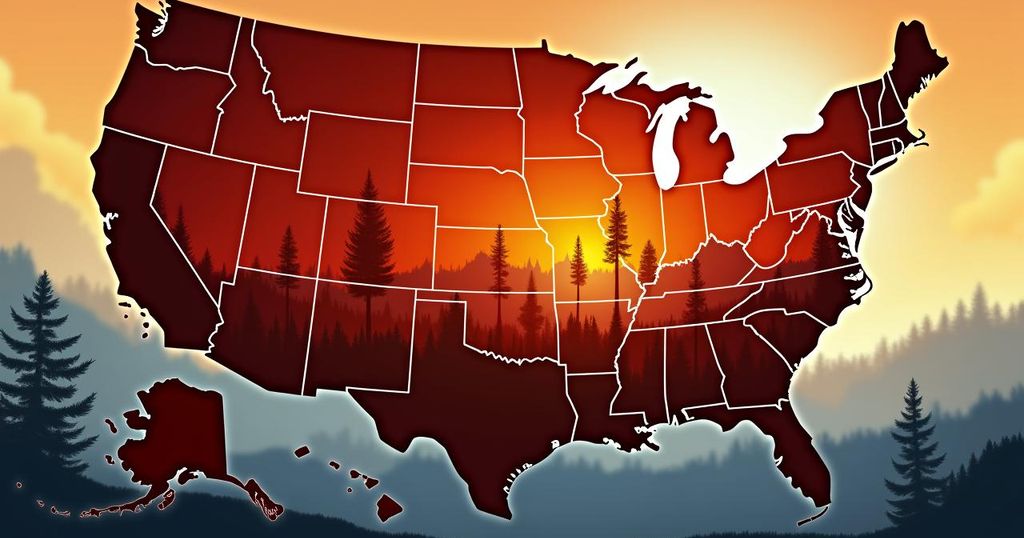Hurricane Helene’s devastation in the U.S. underscores the growing threat of climate change as extreme weather events become more frequent and costly. The hurricane affected previously safe areas, while recovery efforts are complicated by outdated infrastructure. Financial losses from disasters are rising sharply, amplified by population growth and escalating property values. Federal intervention is being discussed as the nation grapples with the reality of climate impacts on communities across the country.
The recent devastation caused by Hurricane Helene exemplifies the escalating threat of climate change-induced extreme weather across the United States. Forecasters had warned of the hurricane’s destructive potential, yet its impact shocked many, resulting in over 180 fatalities and displacing entire communities. Notably, Florida’s Big Bend, which had not faced a hurricane for decades, has now sustained three significant storms in the last year alone. Meanwhile, western North Carolina, once viewed as a refuge from severe weather, is grappling with unprecedented flooding. Natural disasters in the U.S. are not only becoming more frequent but also more costly, as global warming contributes to a volatile atmosphere laden with moisture and energy. According to Mari Tye, a scientist and civil engineer at the National Center for Atmospheric Research, nearly fifty percent of the U.S. populace resides near coastlines, making them increasingly vulnerable to hurricanes and other extreme weather, particularly as infrastructure remains outdated. The frequency of billion-dollar disasters in North Carolina has surged from an average of one or two annually prior to 2009 to approximately six or seven in the current climate reality. This rise in calamities coincides with population growth, complicating recovery efforts, particularly in the wake of Hurricane Helene. Residents are now left without critical resources such as water and power due to extensive damage, including the collapse of essential infrastructure. As Ken Buell from the U.S. Energy Department noted, the complexity of restoration efforts is underscored by the severe nature of the damage. Indeed, many roads, dams, and electrical systems were built for a climate that has since changed significantly. The financial implications of such disasters encompass physical damage and economic impacts, with losses sharply rising in value as the U.S. experiences a real estate boom. Chuck Watson of Enki Research suggests that the heightened financial stakes, alongside rising population figures, contribute to the ease with which total damages can reach billion-dollar thresholds. Hurricane Helene is projected to be one of the costliest storms on record, with estimated damages reaching up to $250 billion. The discussion surrounding federal aid has also intensified, with Congressional representatives signaling the need for federal intervention. Texas holds the unfortunate title of the most disaster-prone state, with 186 billion-dollar weather events recorded since 1980 which have amassed substantial financial losses from extreme weather patterns. Notable events this year include severe wildfires and hurricanes that have wreaked havoc across major areas of the state. The correlation between climate change and extreme weather is evident; the average atmosphere is now holding 7% more moisture for every degree of warming, which, along with heightened ocean temperatures, is fueling more severe and lasting hurricanes. Moreover, inland regions, traditionally less affected by tropical storms, find themselves increasingly at risk as climate conditions change.
The article highlights the alarming increase in the frequency and severity of natural disasters in the United States, attributing these changes largely to climate change. The impacts of global warming are particularly noticeable during severe weather events such as hurricanes, floods, and wildfires. It points out that many regions that were historically safe from extreme weather are now facing serious threats, emphasizing the need for preparedness and adaptation measures. The significant financial implications of these disasters underscore the urgency of the situation, prompting discussions about the role of government and federal aid in disaster recovery efforts.
The escalating intensity and frequency of climate-induced disasters in the U.S., as demonstrated by Hurricane Helene, illustrate the urgent need for communities to prepare for severe weather. The economic ramifications are profound, calling for immediate federal assistance and policy changes to address the evolving landscape of natural disasters. As climate change continues to reshape our environment, proactive measures must be taken to safeguard both people and infrastructure from future storms and other climate-related challenges.
Original Source: www.insurancejournal.com






